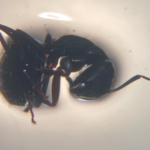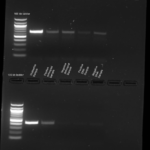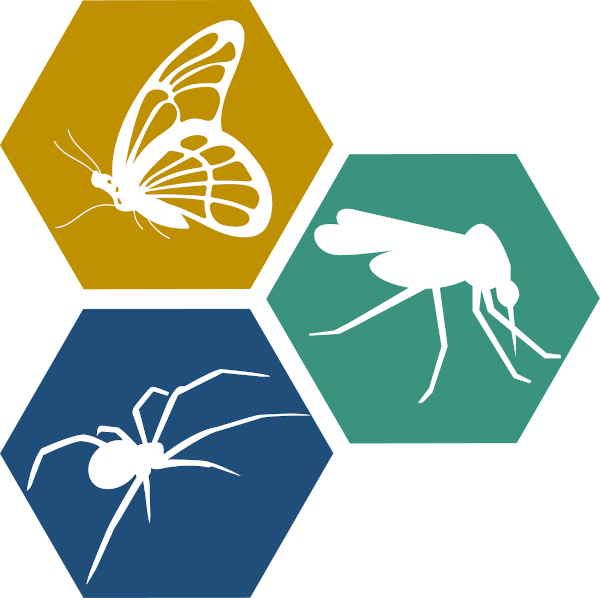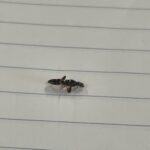Sample information |
|
| Picture |

|
|---|---|
| Location | |
| Collection date | 06/03/2025 |
| Captive / Cultivated? | Wild-caught |
| Group | Pingry School |
| Observations | Big, flat black Carpenter Ant with six legs and a bulbous abdomen covered with fine hair. Found on the ground in the woods, along with a few other carpenter ants that surrounded it. |
| Putative identification | Arthropoda Insecta Hymenoptera Formicidae Camponotus Camponotus pennsylvanicus |
Methods |
|
| Extraction kit | DNeasy (Qiagen) blood and tissue kit |
| DNA extraction location | Abdomen |
| Single or Duplex PCR | Single Reaction |
| Gel electrophoresis system | Standard electrophoresis system |
| Buffer | 1X TAE |
| DNA stain | Cyber Stain |
| Gel images |

|
| Protocol notes | Extraced DNA using the DNeasy extraction kit, and then used the DNA extracted to amplify the Wolbachia and arthropod CO1 genes with PCR. After PCR, took 10 microliters of the PCR product and 4 microliters of loading dye and put into 1.5 mL tubes. Then made 2% agarose gel with TAE buffer with double wells (8 wells, two for 16 wells in total). Then loaded 100 kb ladder (very left). the wells on the top represent arthropod amplified samples and the wells on the bottom represent Wolbachia amplified wells. Annotations in Image, but if not accessible/difficult to see, the order goes (for both top and bottom): Ladder, Bug Sample, Positive Arthropod Control, Negative Arthropod Control, Positive DNA control, Negative DNA control. |
Results |
|
| Wolbachia presence | Yes |
| Confidence level | High |
| Explanation of confidence level | First, the gel had a band for Wolbachia in lane 1 (bottom wells) of 38 bps and a band at the CO1 gene in lane 1 (top wells) of 21 bps, indicating that it is an arthropod infected with Wolbachia. In addition, the arthropod positive control worked for Wolbachia and the arthropod gene, and the arthropod negative control did not show for Wolbachia but did for the CO1 gene. Second, when blasted into the NCBI database, results came up 100% for both the correct Arthropod and Wolbachia endosymbiont. Lastly, fellow classmates with the same arthropod all had Wolbachia present, so likely most of the carpenter ants in the region are infected with it. Thus, I am highly confident this arthropod is infected with Wolbachia. |
| Wolbachia 16S sequence | Download FASTA
Download AB1
TCCTTAGTTACCATCAGGTAATGCTGGGGACTTTAAGGAAACTGCCAGTGATAAACTGGAGGAAGGTGGGGATGATGTCA AGTCATCATGGCCCTTATGGAGTGGGCTACACACGTGCTACAATGGTGGCTATAATGGGCTGCAAAGTCGCGAGGCTAAG CTAATCCCTTAAAAGCCATCTCAGTTCGGATTGTACTCTGCAACTCGAGTGCATGAAGTTGGAATCGCTAGTAATCGTGG ATCAGCACGCCACGGTGAATACGTTCTCGGGTCTTGTACACACTGCCCGTCACGCCATGGGAATTGGTTT
BLAST at The Wolbachia Project BLAST at NCBI
|
| Arthropod COI sequence | Download FASTA
Download AB1
TTGGCTCCTCTATAAGAATAATCATTCGACTAGAGTTAGGATCTCCTGATTCACTAATTCTTAATGATCAAACTTTCAAT ACCATCGTTACAAGTCATGCTTTTATTATAATTTTTTTTATAGTTATACCTTTTATAATTGGGGGATTTGGTAATTTTTT AATTCCACTTATACTAGGATCTCCTGATATAGCTTACCCTCGTTTAAATAACATAAGATTTTGATTACTTCCCCCATCGA TCTCCTTATTAATCCTAAGAAATTTTATTAATGAAGGATCTGGAACTGGTTGAACTATCTACCCCCCTCTATCATCAAAT ACCTTCCATAGTGGCCCCTCTATTGACCTGACTATCTTTTCTCTCCATATTGCTGGTATATCCTCAATTATAGGAGCAAT CAATTTTATTTCAACAATTATAAATATACATAATTCCAATATTTCCCTAGATAAAATTCCCTTATTAGTATGATCTATTC TTATTACAGCTATTCTCCTTCTTCTGTCCCTACCTGTTCTAGCAGGCGCTATTACAATACTACTAACAGACCGAAATCTT AATACTTCATTTTTCGATCCCTCGGGAGGAGGAGATCCTATTTTATA
BLAST at The Wolbachia Project BLAST at NCBI
|
| Summary | The Camponotus pennsylvanicus was found to be postive for Wolbachia. |
 European Paper Wasp
European Paper Wasp Woodworm Ant
Woodworm Ant